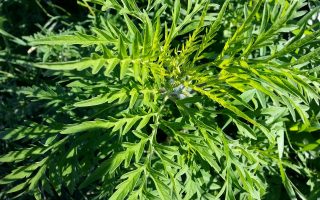
Close up of ragweed, the primary cause of fall allergies.
Mid-July across the United States has been warm and wet, and for many people, summer vacation is in full swing. As hard as it may be to imagine right now, autumn is just around the corner. In little more than 2 months, we’ll begin seeing leaves changing color and an inclination toward lower temperatures. However, there is one side effect of this change in the seasons that is not so pleasant: fall allergies. For those who suffer from allergic reactions related to plant material, autumn can actually be one of the most difficult times of the year. Here’s what you really need to know about getting ready for fall allergies.
What Causes Fall Allergies?
Though most of us tend to think that plants bloom and produce pollen in the spring and die off or go dormant in the wintertime, there are many different variations in the life cycles of plants. One notable and unfortunate example of a deviation from this more normal life cycle pattern is a family of about 17 different species of plants known collectively as ragweed. Ragweed produces truly massive amounts of pollen in late summer and early fall, creating so much of the material that there is virtually no getting away from it. What’s worse, up to 30 percent of people currently living in the United States experience ragweed allergies during the pollination season. Like any allergic reaction, symptoms can range from mild to severe depending on the person and the environment. Given the amount of pollen that can be produced by this common plant, however, large-dose exposure can often lead to more severe symptoms even in those who are not severely allergic.
When do Fall Allergies Really Start?
“Fall Allergies” is, itself, a bit of a misnomer. Though they occur most frequently in September and early October, ragweed allergies can begin as early as very late July or early August. This means that, for many parts of the country, ragweed season’s start is only a few weeks away. What’s worse, it is becoming increasingly apparent that shifts in localized and regional climates are beginning to extend ragweed season. As the average global temperature gradually rises, first frosts (which end ragweed season by killing off the plants) slowly get pushed back into slightly later parts of the year. Though this phenomenon produces only very small variations on a year to year basis, the cumulative effect over several decades has been to slightly extend the ragweed season. Thus, as this trend continues, ragweed sufferers can expect to gradually see longer and longer average allergy seasons.
How to Combat Fall Allergies
With all of this basic information about fall allergies, how they work, what causes them and how long their seasons last, what is to be done about them? The answer, as with all types of allergies, is to limit exposure to the allergen in question (in this case, ragweed pollen). In the case of ragweed, however, this is much easier said than done. A single ragweed plant can produce as many as 1 billion individual grains of pollen across the course of a single growing season, provided that it has adequate environmental resources to do so, i.e enough water, sunlight and high enough average temperatures. This means that escaping from ragweed pollen in areas where tens of thousands of the common plants might be growing is fantastically difficult. The good news is that there are some very effective ways to limit your exposure, if not cut it out completely. Here are a few of the basics:
- Avoid being outdoors during the hotter hours of the day, when pollen production is most active
- Cut down any ragweed plants in your yard now. This will prevent them from reaching the stage of their life cycle when pollen is produced in the coming weeks.
- Don’t bring anything from outdoors into your home with you. If you suffer from severe allergies, this should even stretch to include changing your clothes and shoes as soon as your come inside and washing the ones you wore out to prevent the spread of pollen in your house.
- Change your diet. Certain foods contain histamines that can make allergic reactions worse. Typically, these will be aged or fermented foods, or those that contain yeast. Cutting out yogurt, bread, cheeses and all forms of alcohol can help to increase the amount of exposure to pollen that will be needed to set off an allergic reaction.
- Use a HEPA air purifier. These purifiers are certified to remove 99.7 percent of airborne contaminants 0.3 microns in size or greater. This kind of filtration can cut the amount of ragweed pollen in your home down to virtually nothing, keeping your house clean and allergen free.
Of the items on this list, the last is particularly important in dealing with fall allergies (or, indeed, any pollen allergies). Your control over the air outside your home and the prevalence of ragweed pollen in your area will always be very limited, but using an air purifier inside your home can give you an extremely high degree of control over the air you breathe where you live. For maximum results, we at US Air Purifiers recommend a HEPA residential air purifier combined with a Foobot indoor air quality monitoring system. While the air purifier removes pollen, the monitoring system lets you know exactly what the air quality in your home is like and gives you helpful tips for improving it.
Have questions about using air purification technology to make your home healthier and safer? We’re here to help. Feel free to contact us with your questions, and we’ll reply with useful information and recommendations tailored to your needs.